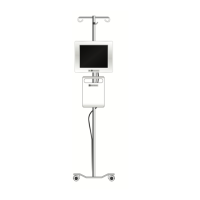F-2
Guidance and Manufacturer's Declaration
Table F-2 Electromagnetic Emissions
Guidance and Manufacturer's Declaration - Electromagnetic Emissions
The EV1000 Clinical Platform NI is intended for use in the electromagnetic environment specified below. The customer or user of
the EV1000 Clinical Platform NI should assure that it is used in such an environment.
Emissions Compliance Description
RF emissions
CISPR 11
Group 1 The EV1000 Clinical Platform NI uses RF energy only for its internal
function. Therefore, its RF emissions are very low and are not likely
to cause any interference with nearby electronic equipment.
RF emissions
CISPR 11
Class A The EV1000 Clinical Platform NI is suitable for use in all
establishments other than domestic and those directly connected to
the public low-voltage power supply network that supplies buildings
used for domestic purposes.
Harmonic emissions
IEC 61000-3-2
Class A
Voltage fluctuation/ Flicker emissions
IEC 61000-3-3
Complies
Table F-3 Recommended Separation Distances between Portable and Mobile RF Communications Equipment and the
EV1000 Clinical Platform NI
The EV1000 Clinical Platform NI is intended for use in an electromagnetic environment in which radiated RF disturbances are controlled. To
help prevent electromagnetic interference, maintain a minimum distance between portable and mobile RF communications equipment
(transmitters) and the EV1000 Clinical Platform NI as recommended below, according to the maximum output power of the communications
equipment.
Transmitter Frequency 150 kHz to 80 MHz 80 to 800 MHz 800 to 2500 MHz
Equation
d = 1.2 d= 1.2 d= 2.3
Rated Maximum Output
Transmitter Power (watts)
Separation Distance
(meters)
Separation Distance
(meters)
Separation Distance
(meters)
0.01 0.12 0.12 0.24
0.1 0.37 0.37 0.74
11.21.22.3
10 3.7 3.8 7.4
100 12 12 23
For transmitters rated at a maximum output power not listed above, the recommended separation distance d can be estimated using the
equation in the corresponding column, where P is the maximum output power rating of the transmitter in watts according to the transmitter
manufacturer.
NOTE 1: At 80 MHz and 800 MHz, the separation distance for the higher frequency range applies.
NOTE 2: These guidelines may not apply in all situations. Electromagnetic propagation is affected by absorption and reflection from
structures, objects, and people.

